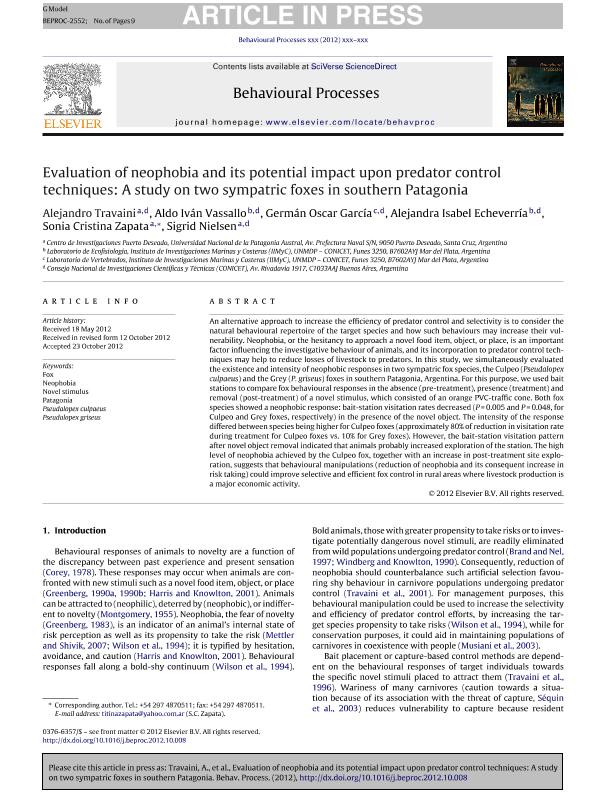Mostrar el registro sencillo del ítem
dc.contributor.author
Travaini, Alejandro

dc.contributor.author
Vassallo, Aldo Iván

dc.contributor.author
García, Germán Oscar

dc.contributor.author
Echeverría, Alejandra Isabel

dc.contributor.author
Zapata, Sonia Cristina

dc.contributor.author
Nielsen, Sigrid

dc.date.available
2017-08-28T18:33:50Z
dc.date.issued
2012-10
dc.identifier.citation
Travaini, Alejandro; Vassallo, Aldo Iván; García, Germán Oscar; Echeverría, Alejandra Isabel; Zapata, Sonia Cristina; et al.; Evaluation of neophobia and its potential impact upon predator control techniques: A study on two sympatric foxes in southern Patagonia; Elsevier; Behavioural Processes; 92; 10-2012; 79-87
dc.identifier.issn
0376-6357
dc.identifier.uri
http://hdl.handle.net/11336/23132
dc.description.abstract
An alternative approach to increase the efficiency of predator control and selectivity is to consider the natural behavioural repertoire of the target species and how such behaviours may increase their vulnerability. Neophobia, or the hesitancy to approach a novel food item, object, or place, is an important factor influencing the investigative behaviour of animals, and its incorporation to predator control techniques may help to reduce losses of livestock to predators. In this study, we simultaneously evaluated the existence and intensity of neophobic responses in two sympatric fox species, the Culpeo (Pseudalopex culpaeus) and the Grey (P. griseus) foxes in southern Patagonia, Argentina. For this purpose, we used bait stations to compare fox behavioural responses in the absence (pre-treatment), presence (treatment) and removal (post-treatment) of a novel stimulus, which consisted of an orange PVC-traffic cone. Both fox species showed a neophobic response: bait-station visitation rates decreased (P = 0.005 and P = 0.048, for Culpeo and Grey foxes, respectively) in the presence of the novel object. The intensity of the response differed between species being higher for Culpeo foxes (approximately 80% of reduction in visitation rate during treatment for Culpeo foxes vs. 10% for Grey foxes). However, the bait-station visitation pattern after novel object removal indicated that animals probably increased exploration of the station. The high level of neophobia achieved by the Culpeo fox, together with an increase in post-treatment site exploration, suggests that behavioural manipulations (reduction of neophobia and its consequent increase in risk taking) could improve selective and efficient fox control in rural areas where livestock production is a major economic activity.
dc.format
application/pdf
dc.language.iso
eng
dc.publisher
Elsevier

dc.rights
info:eu-repo/semantics/openAccess
dc.rights.uri
https://creativecommons.org/licenses/by-nc-sa/2.5/ar/
dc.subject
Neophobia
dc.subject
Novel Stimulus
dc.subject
Patagonia
dc.subject
Pseudalopex Culpaeus
dc.subject
Fox
dc.subject
Pseudalopex Griseus
dc.subject.classification
Bioquímica y Biología Molecular

dc.subject.classification
Ciencias Biológicas

dc.subject.classification
CIENCIAS NATURALES Y EXACTAS

dc.title
Evaluation of neophobia and its potential impact upon predator control techniques: A study on two sympatric foxes in southern Patagonia
dc.type
info:eu-repo/semantics/article
dc.type
info:ar-repo/semantics/artículo
dc.type
info:eu-repo/semantics/publishedVersion
dc.date.updated
2017-08-25T19:54:51Z
dc.journal.volume
92
dc.journal.pagination
79-87
dc.journal.pais
Países Bajos

dc.journal.ciudad
Ámsterdam
dc.description.fil
Fil: Travaini, Alejandro. Universidad Nacional de la Patagonia Austral. Unidad Académica Caleta Olivia. Centro de Investigaciones Puerto Deseado; Argentina. Consejo Nacional de Investigaciones Científicas y Técnicas; Argentina
dc.description.fil
Fil: Vassallo, Aldo Iván. Universidad Nacional de Mar del Plata. Facultad de Ciencias Exactas y Naturales. Departamento de Biología. Laboratorio de Ecofisiología; Argentina. Consejo Nacional de Investigaciones Científicas y Técnicas. Centro Científico Tecnológico Conicet - Mar del Plata. Instituto de Investigaciones Marinas y Costeras. Universidad Nacional de Mar del Plata. Facultad de Ciencia Exactas y Naturales. Instituto de Investigaciones Marinas y Costeras; Argentina
dc.description.fil
Fil: García, Germán Oscar. Universidad Nacional de Mar del Plata. Facultad de Ciencias Exactas y Naturales. Departamento de Biología. Laboratorio de Invertebrados; Argentina. Consejo Nacional de Investigaciones Científicas y Técnicas; Argentina
dc.description.fil
Fil: Echeverría, Alejandra Isabel. Consejo Nacional de Investigaciones Científicas y Técnicas. Centro Científico Tecnológico Conicet - Mar del Plata. Instituto de Investigaciones Marinas y Costeras. Universidad Nacional de Mar del Plata. Facultad de Ciencia Exactas y Naturales. Instituto de Investigaciones Marinas y Costeras; Argentina. Universidad Nacional de Mar del Plata. Facultad de Ciencias Exactas y Naturales. Departamento de Biología. Laboratorio de Ecofisiología; Argentina
dc.description.fil
Fil: Zapata, Sonia Cristina. Universidad Nacional de la Patagonia Austral. Unidad Académica Caleta Olivia. Centro de Investigaciones Puerto Deseado; Argentina
dc.description.fil
Fil: Nielsen, Sigrid. Universidad Nacional de la Patagonia Austral. Unidad Académica Caleta Olivia. Centro de Investigaciones Puerto Deseado; Argentina. Consejo Nacional de Investigaciones Científicas y Técnicas; Argentina
dc.journal.title
Behavioural Processes

dc.relation.alternativeid
info:eu-repo/semantics/altIdentifier/doi/http://dx.doi.org/10.1016/j.beproc.2012.10.008
dc.relation.alternativeid
info:eu-repo/semantics/altIdentifier/url/http://www.sciencedirect.com/science/article/pii/S0376635712002252
Archivos asociados
